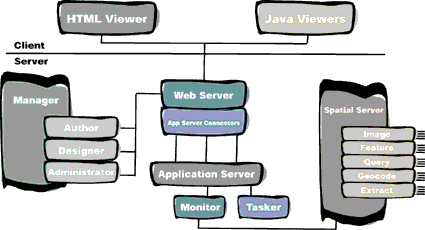



|
|
||
 |
 |
|
 |
 |
|
ArcIMS ArchitectureSpecifically built to serve GIS on the Internet, ArcIMS is designed to make it easy to create map services, develop Web pages for communicating with map services, and administer sites.  ArcIMS operates in a distributed environment and consists of both clientside and serverside components. Typically, the client requests information from an Internet or Intranet server. Then the server processes the request and sends the information back to the client viewer. Serverside ComponentsThe ArcIMS serverside components include
ArcIMS Spatial ServerThe ArcIMS Spatial Server processes requests for maps and related information. When a request is received, the ArcIMS Spatial Server performs functions such as
Two middleware processes, the ArcIMS Monitor and the ArcIMS Tasker, run in the background to support the ArcIMS Spatial Server. These can operate as either Windows NT services or daemon processes (on UNIX).
ArcIMS Application ServerThe ArcIMS Application Server handles the load balancing of incoming requests ArcIMS Application Server ConnectorsThe ArcIMS Application Server Connectors are used to connect the Web server to the ArcIMS Application Server. ArcIMS provides three connectors:
The Servlet Connector is the standard connector used for ArcIMS. It uses the ArcIMS language, ArcXML, to communicate from the Web server to the ArcIMS Application Server. ArcXML is the ArcIMS version of eXtensible Markup Language (XML). The Cold Fusion and ActiveX connectors work with custom clients and translate their own languages into ArcXML. ArcXMLArcIMS communicates between the different components using ArcXML. These ArcXML files look similar to HTML pages. The difference is that HTML describes the page structure for display while ArcXML provides the structure for describing the content. ArcXML tags and attributes provide the structure for
Clientside ComponentsRequests are sent from three types of ArcIMS viewers:
ArcIMS includes clientside viewers:
ArcIMS includes HTML and Java viewers as well as ArcExplorer 3 (Java edition). Users can customize templates to add logos, graphics, colors, and functions. The ArcIMS viewers determine the functionality and graphical look of the site. This is the map view that will be displayed in the end user's Web browser. Next >> ArcIMS Manager |